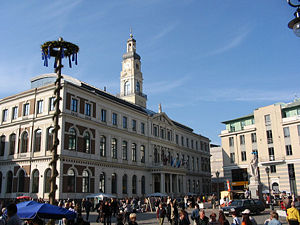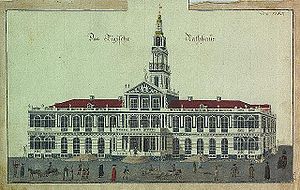- Riga City Council
-
Riga City Council (Latvian: Rīgas Dome) is the government of Riga City, the capital of Latvia. It is located in the Riga Town Hall at the Town Hall Square (Rātslaukums) in the very heart of Riga.
The Riga City Council consisting of 60 councillors who are elected every 4 years is established on the basis of party factions.
The work of the Riga City Council is organized by the Chairman (currently Nils Ušakovs), deputy chairmen, the Presidium, City Executive Director, District Executive Directors and the staff of municipal institutions and enterprises.
The Presidium of the Riga City Council consists of the Chairman of the Riga City Council and the representatives delegated by the political parties or party blocks elected to the City Council.
Contents
History of Riga Municipality
Early days
The heads of Riga, representing the town inhabitants, were mentioned in documents already in 1210. It is unknown when the first town council was formed, but the members of the town council took part in signing treaties in Riga in 1225.
In the 13th century the town council governed the town and acted as legislature, but in the 14th century – also as a judicial authority. At the same time the town council managed the town protection problems, imposed taxes, represented the interests of Riga’s inhabitants in foreign affairs, signed agreements and appointed ambassadors. However, a communal assembly of Riga inhabitants preserved a great role in settling important and extraordinary problems. In the first half of the 13th century the councilmen of the town council were elected for one year, but at the end of the century already the town council itself selected successors to councilmen posts. The post of councilman position actually became a lifelong post.
The rights of the town council were restricted after Riga became subordinate to the King of Poland and Lithuania, Stefan Báthory (1581).
Disagreements between the Riga Town Council and guilds about the right of governing the town became aggravated at the end of the 16th century. It reached its culmination during the so-called “Calendar Unrests” (1584–1589), though the town council maintained its dominance. Discordance flared up again in the first half of the 17th century when guilds managed to gain support from Sweden which governed Riga at that time.
After Riga fell into the jurisdiction of Russia (1710), it became a province center, and after the reforms of 1783, Riga’s local administration was governed by a governor- general. However, the town council, representing the interests of the German nobility, tried to preserve its influence in Riga. With alternating success it managed to do so by 1889. An administrative town reform took place in Russia in 1870, reaching also Riga in 1877.
The 20th century
The City Council and the City Board were formed, and the City Mayor was elected. During the Independent Republic of Latvia (1918–1940) Riga was officially recognized as the capital of Latvia (1931), with the Riga City Council governing it. After the governmental overturn of 1934, the Cabinet of Ministers became the head of the city.
After the Soviet occupation in 1940, administrative structure of Riga was reorganized. A provisional Executive Committee was formed. In 1941, the city was divided into six districts to facilitate police surveillance and management of nationalized properties. Such a system was preserved also after World War II; from time to time the number of districts and borderlines has changed. The Deputy Council of Working People (from 1977 – People’s Deputy Council) governed Riga. It was elected once in two years (from 1979 – in 2.5). The Council elected the Executive Committee. In reality these procedures were formal, and the city administration realized decisions inspired by the totalitarian regime’s leading organs.
On May 4, 1990 the Supreme Council of the Latvian SSR adopted the Declaration on Restoring Independence of the Republic of Latvia, which introduced the period of rebuilding the structure of state power and administration in Latvia, including the Riga City administration reform.
The process of restructuring started on February 15, 1990 with the laws adopted by the Supreme Council on the local governments of rural municipalities, regions, towns and cities. Pursuant to these laws the People’s Deputy Council from its members elected the Chairman of the Council, the Deputy Chairman and his/her secretary.
Andris Teikmanis, representative from the Popular Front of Latvia, was elected the Chairman of the People’s Deputy Council of Riga. Under the guidance of A. Teikmanis, the People’s Deputy Council of Riga voted for using the historical coat of arms and banner of Riga - a symbolic contribution to the continuity of the city’s heritage.
Simultaneously, major changes took place in the city life and in the work of the municipal structural units linked with the changes in property forms and in the formation of the city budget.
The law “On the Local Government of the Capital City Riga” passed on June 10, 1992 changed the city administration system in the very core. The Riga City Council, consisting of 60 councillors, became the largest administrative body of the city. 30 out of the 60 councillors were elected by the People’s Deputy Council of Riga from its members and the other 30 were elected by the Councils of the Riga City districts; five councillors from each district. Presidium and Executive Committee of the People’s Deputy Council of Riga were abolished and replaced by the City Board consisting of 11 members. Andris Teikmanis was elected Chairman of the Riga City Council. The district boards were established instead of executive committees, which were led by the executive directors of the districts.
On August 26, 1993 the Riga City Council passed a resolution “On the Reform of the Riga Local Government”. It suggested to the Parliament to create in Riga a one-level local government with one administrative body, i.e. Riga City Council with 60 councillors and the executive body under the Riga City Council – the Riga City Board. On May 19, 1994 the Saeima passed the law following which the Riga City Council was elected in the municipal elections of May 29, 1994.
A one-level local government, the Riga City Council with 60 elected councillors, was set up in Riga. Māris Purgailis was elected the Chairman of the City Council. 11 Standing Committees were established (Finance Committee, City Development Committee, Committee for Housing Issues, Municipal Property and Privatization Committee, Environment Protection Committee, Education, Youth and Sports Committee, Culture, Arts and Religion Committee, Committee for Municipal and Transport Affairs, Social Affairs Committee and Order Committee, Committee for Matters of Foreigners and Stateless Persons).
Executive power was exercised by the Executive Director of the Riga City Council, whose deputies were also heads of departments (City Development Department, Property Department and Department of Finance). In the districts administrative functions were performed by the district boards appointed the Riga City Council; district boards were led by directors. Every district board included six departments, district commissions as well as branches of the Riga City Council directorates and departments.
The next municipal elections took place on March 9, 1997. Andris Bērziņš was elected the Chairman of the City by the new Council. On May 5, 2000 he was appointed the Prime Minister and already on May 9 the RCC elected his successor Andris Ārgalis. The RCC structure also underwent some changes. The Council had to elect the Chairman and two Deputy Chairmen from among its members. The number of standing committees was also reduced to nine (Security and Order Committee and Committee for Matters of Foreigners and Stateless Persons were abolished). Chairmen of the Committees formed the Council’s Board. The Riga City Council employs the Executive Director of the Riga City to whom executive boards of the city districts and the Maintenance Division of the RCC are subject.
The 21st century
The next municipal elections were held on March 11, 2001. Gundars Bojārs was elected the Chairman of the City Council, and Sergejs Dolgopolovs and Aivars Guntis Kreituss were elected Deputy Chairmen. As compared to the previous Riga City Council, the number of standing committees increased to ten, by restoring the Security and Order Committee. The Board of the City Council was replaced by the Presidium of the Riga City Council.
After the municipal elections in 2005, Aivars Aksenoks became Chairman of the City council. Deputy chairmen were Andris Ārgalis, Jānis Birks and Almers Ludviks (the last one replaced Juris Lujāns in summer 2005). In 2007, Jānis Birks became chairmen with Jānis Dinevičs replacing him as deputy chairman.
The Town Hall Building
Just underneath the Riga City Council building (destroyed during WWII, rebuilt in 2003) is a narrow cobble-stone street which is home to different souvenir and flower shops, a giant cascading waterfall three stories high and the remains of an ancient tree stub unearthed during the re-construction process. A small plaque states that when this oak was growing on the banks of the River Daugava.
Mayors of Riga
Name Party Start End Māris Purgailis Latvian National Independence Movement 1994 1997 Andris Bērziņš Latvian Way 1997 2000 Andris Ārgalis For Fatherland and Freedom/LNNK 2000 2001 Gundars Bojārs Latvian Social Democratic Workers' Party 2001 2005 Aivars Aksenoks New Era Party 2005 2007 Jānis Birks For Fatherland and Freedom/LNNK 2007 2009 Nils Ušakovs National Harmony Party 2009 Present day External links
- www.riga.lv Official website
- Riga City Council Place to find all the necessary information and links about Riga City Council
- The Town Hall Square and the Blackheads House on the portal "Other Riga"
Categories:- City councils
- Riga
Wikimedia Foundation. 2010.


